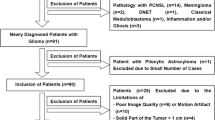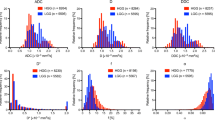Abstract
Introduction
Some investigators have suggested that medulloblastomas can be distinguished from other cerebellar neoplasms by demonstrating “restricted diffusion” on the Apparent Diffusion Coefficient (ADC) map obtained from diffusion-weighted imaging (DWI) sequences on magnetic resonance imaging. Previous authors have postulated that this observed restricted diffusion is a reflection of very high cell density. There has been a tendency to assert that pediatric medulloblastoma uniformly demonstrates restricted diffusion on DWI. However, our clinical observation has been that there are pediatric medulloblastomas that exhibit normal or even increased diffusion on DWI. The current study was undertaken primarily to determine whether restricted diffusion is uniformly present in pediatric medulloblastoma and secondly to look for pathological features that might distinguish medulloblastomas with and without restricted diffusion.
Methods
The DWI characteristics of pathologically confirmed medulloblastomas diagnosed at our institution were retrospectively reviewed. The ADC was obtained in two non-overlapping, solid, non-hemorrhagic, non-necrotic regions of tumor and averaged. An ADC below 1 × 10−3 mm2/s was considered to represent restricted diffusion. A detailed pathologic review of each tumor was conducted.
Results
Ten cases of medulloblastoma were reviewed, of which two demonstrated average ADCs above 1 × 10−3 mm2/s (1.223 and 1.169 × 10−3 mm2/s, respectively), indicating no restricted diffusion. Pathologic review revealed that both of these non-restricting cases displayed a lack of reticulin deposition by light microscopy.
Conclusion
DWI does not appear to be an entirely reliable means of distinguishing medulloblastomas from other cerebellar neoplasms. Histologically, restricted diffusion in medulloblastomas may be related to reticulin deposition.



Similar content being viewed by others
References
Bulakbasi N, Guvenc I, Onguru O, Erdogan E, Tayfun C, Ucoz T (2004) The added value of the apparent diffusion coefficient calculation to magnetic resonance imaging in the differentiation and grading of malignant brain tumors. J Comput Assist Tomo 28(6):735–746
Gurney J, Smith M, Bunin G (1999) CNS and miscellaneous intracranial and intraspinal neoplasms. In: Ries L, Smith M, Gurney J, et al. (eds) Cancer incidence and survival among children and adolescents: United States SEER Program 1975–1995, National Cancer Institute, SEER Program, vol NIH Pub. No. 99–4649. National Cancer Institute, Bethesda, MD, pp 51–64
Kan P, Liu JK, Hedlund G, Brockmeyer DL, Walker ML, Kestle JR (2006) The role of diffusion-weighted magnetic resonance imaging in pediatric brain tumors. Childs Nerv Syst 22(11):1435–1439
Kono K, Inoue Y, Nakayama K, Shakudo M, Morino M, Ohata K, Wakasa K, Yamada R (2001) The role of diffusion-weighted imaging in patients with brain tumors. Ajnr 22(6):1081–1088
Louis DNOH, Wiestler OD, Cavenee WK (eds) (2007) WHO Classification of tumors of the central nervous system, 4th edn. IARC, Lyon
Rumboldt Z, Camacho DL, Lake D, Welsh CT, Castillo M (2006) Apparent diffusion coefficients for differentiation of cerebellar tumors in children. AJNR 27(6):1362–1369
Yamasaki F, Kurisu K, Satoh K, Arita K, Sugiyama K, Ohtaki M, Takaba J, Tominaga A, Hanaya R, Yoshioka H, Hama S, Ito Y, Kajiwara Y, Yahara K, Saito T, Thohar MA (2005) Apparent diffusion coefficient of human brain tumors at MR imaging. Radiology 235(3):985–991
Financial disclosure
No financial relationships exist that are relevant to this study.
Conflict of interest
The authors would like to declare that no conflict of interest exists.
Ethics
Ethical approval for this study was provided by the University of British Columbia and Children's and Women's Health Centre Research Ethics Board, approval number CW10-0241/H10-02382. All research activities were performed in accordance with the ethical standards of good clinical practice as outlined in the 1964 Declaration of Helsinki.
Author information
Authors and Affiliations
Corresponding author
Additional information
Declaration: This work was presented in abstract form at the Canadian Association of Neuropathologists (CANP) 50th Annual General Meeting, Toronto Ontario, October 14–16, 2010.
Rights and permissions
About this article
Cite this article
Pillai, S., Singhal, A., Byrne, A.T. et al. Diffusion-weighted imaging and pathological correlation in pediatric medulloblastomas—“They are not always restricted!”. Childs Nerv Syst 27, 1407–1411 (2011). https://doi.org/10.1007/s00381-011-1499-5
Received:
Accepted:
Published:
Issue Date:
DOI: https://doi.org/10.1007/s00381-011-1499-5




